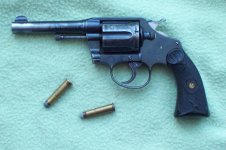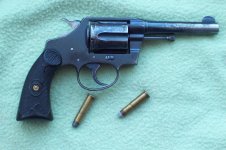I own a 1922 Army Special, Colt SAA custom 3rd gen, and 94CL Marlin in 32-20. The 32-20 is a
great cartridge for varmints and can be used up close for deer. It is not a long range rifle, but will shoot as far as you can see with iron sights. I have used mine on feral hogs of less than 100 pounds. In all honesty I have seen hogs drop to cast 32-20s quicker than hot 357s.
The 32-20 was originally a black powder cartridge for the 1873 Winchester and
the Colt SAA. It was later loaded in the
20th century in many smokeless loadings with all the manufacturers offering a lead or jacketed soft pointing, a full metal case for hide hunters, and a "rifle only" 80 gr hollowpoint loading called 32-20 high velocity.
The high velocity load was discontinued in the 1960s, but are readinly availaible on the internet. I collect them and hunt with them.
They were a good 100 yard varmint gun.
The modern 32-20 loads are fine in all rifles and pistols that were proofed for smokeless.
The high velocity rounds were intended to be fired in 1892 Winchester, Marlin 94, and bolt actions. It was not to be fired in the Colt or S&W revolvers or the Winchester 1873. These high velocity loads were fired in revolvers by many people including myself. If you are carrying a 32-20, you want all the bang you can get. Vintage sources say the only pistols capable of handling the hi pressure load was the Colt SAA because its cylinder was so thick and later SAA were capable of being chambered in 357 Magnum. Whatever the case, they will wear a pistol out. Some of the little framed Colts will stretch if they are fired with them. Some said the Army Special was good with them, but I am not putting them in mine.
Ballisticly, modern 32-20 loadings are like the 32 S&W Long from a revolver. Manufacturers loaded the 32-20 down beginning in the 1950s.
Some of the 1940s vintage ammo I have chronographed goes 150 fps faster than modern loads. I handload mine back to the old loads.
I have an old Skeeter Skelton load for the 32-20
SAA that propels a 115 gr cast slug to 1150 fps and is within standard pressure limits. That is the ballistic duplicate of the 9m/m.
From a rifle, modern 100 gr lead loads clock 1250 fps. This load from my Marlin dropped a 100 lb deer dead in her tracks. The original high velocity loading propelled an 80 gr slug to 2000 fps!! I handload a 100 gr XTP to 1700 fps and that would be great on deer within 75 yards.
You really need to handload for the 32-20 to get full potential. Basically the 327 Fed Mag
is like the old high velocity "whv" loads.
The 32 HR Mag pistol is about like a 32-20 rifle with a standard load.
Also, the 1892 rifle is a very strong lever action and can be loaded pretty stout.
The only bad thing about the 32-20 is that it has the most ear piercing muzzle blast from a pistol- much like the 357. It is not bad from a rifle.
I have enjoyed the 32-20 because it is just so much fun. It is not hard to reload once you get the hang of it and the guns chambered for it are my favorite types.


